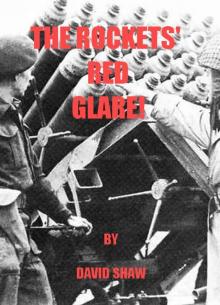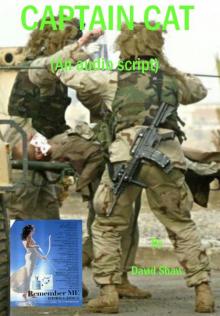- Home
- David Shaw
The Rockets' Red Glare Page 2
The Rockets' Red Glare Read online
Page 2
carried out using one hand.
When asked why he'd wanted such a departure from normal practice, the Duke explained that in other light aircraft he'd often wished on cold days that he could fly with a motoring rug spread over his legs and in the Autoplane he could!
The Master Gunner pondered on this point. It seemed to him that any controls which allowed a pilot to fly with a large map board resting on top of his legs might be an excellent idea for an artillery spotting aircraft. The further thought occurred that if the Army aircraft had a different set of controls from standard aircraft, then that would be an excellent excuse for telling the RAF to sod off if they tried to take over the Autoplane.
The Duke then demonstrated the hatches which opened up the ample luggage space behind the cockpit. So ample in fact that a jump seat had been installed in it for a third passenger, if required.
The Autoplane seemed to be just what was required. It was a proven design, it had plenty of space to fit a radio set, it was conceived with ease of manufacture in mind and the airframe only required five hundred pounds of wood. The engines could be directly imported from America without interfering with the production of any RAF or Fleet Air Arm aircraft. Furthermore, the dual controls meant that the Army pilots can be trained from scratch in the aircraft they would fly on operations. And, naturally, if the pilot was wounded and the passenger another pilot, then the dual controls enabled him make an emergency landing.
The MG asked the Duke about the blueprints and jigs. The Duke said they still existed, in fact he and Edmund Hordern had started a company called Hordern-Richmond Aircraft Ltd to manufacture the Autoplane, but the onset of the war had forced the abandonment of that idea. The Master Gunner told his Grace the company was now back in business. They returned to the estate Mansion where the Duke called for his secretary and his butler. The butler was ordered to open a bottle of champagne, the secretary to type out a one page authorisation for the Army to buy the Hordern-Richmond Autoplane for flight tests with a view to beginning production immediately if proved satisfactory.
The only snag is that 'Autoplane' didn't sound martial enough. Suggestions are called for. The butler -- an ex-green jacket -- won by suggesting the Hordern-Richmond Sharpshooter.
One month later, spring has arrived in Europe and the first experimental rocket battery is being unloaded in Calais. Their Sharpshooter, the original and so far the only one, has already flown over the Channel. Apart from fitting a radio set, other modifications have been made to it. A rubber self sealing lining has been fitted to an enlarged petrol tank which now provides an endurance of three and a half hours. The danger of attack by enemy fighters has been considered and several rear vision mirrors have been mounted at the top of the cockpit canopy to provide the best possible view of the sky behind and above the tail. For the same reason four ten pound smoke dischargers are now mounted underneath the fuselage, in a row between the undercarriage legs.
The intention is that, if attacked, the pilot can electrically fire each smoke discharger in sequence. Each canister releases a stream of green coloured smoke which is intended to make it as difficult as possible for high speed fighters to get their sights on a tiny green aircraft flying a few feet above green fields with a green mist trailing behind it. In fact, fighter affiliation trials with a Hurricane almost ended in the Hurricane crashing by flying into a tree it didn't see in the smoke. A further refinement has been the fitting of a length of aluminum one inch tubing across the back of the smoke dispensers, with the open ends of the tube behind the propellers. Thus the smoke is drawn out into the prop wash and instantly dispersed as widely as possible.
So, the Sharpshooter and the Tulip battery are ready to go to war. Only they don't have to bother because this is May 11th, 1940, and the war is already coming towards them. Coming towards them very, very quickly. Guderian is leading his Panzer Divisions forward in avalanche of dust, blood and hot steel like Genghis Khan in a homicidal rage.
Unlike Guderian, the allied generals are not inside their tanks with their radios switched on -- very few allied generals have ever been inside a tank or used a radio in their lives. They are sitting in offices, dictating their orders, waiting for them to be typed, checked, re-typed again onto duplicating skins, run off on printers, filed and finally sent off by despatch riders. It's not a war between armies, it's a war between two different nervous systems, and one of them is in an advanced state of senility.
Ten days later and the British have decided not to march to the sound of the guns anymore but to the sound of the waves. Unfortunately the Germans are already on the beach, because it's now the 21st of May and the leading Panzer crews are paddling in the English Channel at Noyelles. They've travelled 200 miles in ten days and the operation has been about as difficult as a bunch of Al Capone's gangsters turning over an old folks' home. All the Panzers need to do now is make a smart right turn, drive north along the coast and cut the British Army's access to the coastal ports. And then to march the entire British order of battle off to their prison camps in the Third Reich. It's a great day for the German Army.
But Lord Gort, the commander of the British Expeditionary Force, has decided to make the 21st of May his day as well. Scraping together whatever forces he can, he launches a counter attack into the flank of the Panzer corridor at Arras. The French are supposed to be taking part as well but never show up. Unfortunately there are more Germans than expected. Fifty eight British Matilda Tanks supported by two battalions of infantry run straight into the Seventh Panzer Division and part of the Third Waffen SS "Death's Head" Division.
It's the opening surprise in one of the the oddest encounters in military history. The British get the first surprise at finding out the strength of the opposition they've run into, the Germans the second one when their 37mm anti-tank guns prove useless against the thick armour of the Matildas. Very quickly the Germans become infected with the same 'tank fear' which has infected so many allied units and begin to fall apart in confusion and a rising tide of panic. Even the SS turn and run, for the first and last time in their history.
Now it's the German divisional commander's turn to play an unexpected card. He lines up the 88mm flak guns of his anti-aircraft regiment and begins to fire down on the advancing British tanks from a wooded crest line. And every time an 88 gun is fired another Matilda shudders to a halt, the formerly invulnerable armour as useless as bird feathers against a shotgun blast. And overhead, two men and a radio inside a tiny wooden plane prepare to throw in the last and biggest surprise of the day.
The Sharpshooter was overlooking the advance on Arras that afternoon because Lord Gort had suggested that if the rocket battery had something useful to contribute to the war, that was the place to do it. The Tulip convoy had driven all night and half the day a through a tangle of conflicting road movements to get to Arras in time to support the counter attack, and only managed it because Gort's Chief of Staff had given them a priority movement order to show to the Military Police on point duty.
And in this instance the duplicator won the day because the battery CO ran off a hundred copies of the movement order and ordered the Sharpshooter to drop a copy to any MP’s seen ahead on the battery’s route. In consequence, there was no need to stop and explain the situation at each cross roads. The circling presence of the Sharpshooter emphasized the importance of the written orders and they were enforced quickly and efficiently by the red capped traffic controllers.
In fact it was the Sharpshooter which located the HQ of General Franklyn, the officer commanding the counter attack, and guided the rocket troops to it. They arrived just in time to take part the operation. As the tanks advanced and outran their artillery support the Tulip lorries followed up closely in case they were needed. Until they were suddenly needed very badly indeed.
Seeing the Matilda tanks being slaughtered the pilot of the Sharpshooter carried out a previously agreed emergency procedure for calling in fire support. He climbed to 1,000 feet above the German gunline and began ci
rcling. Then he switched on a smoke dispenser. The Germans looked up in puzzlement at the spreading trail of green smoke above them with the sound of tiny engines buzzing away inside it as though they were being pestered by some overgrown model aircraft. But whatever was happening it didn't seem to be doing them any harm.
Meanwhile the Tulip battery commander had deployed his launchers and ordered them to aim at the windward edge of the spreading smoke trail. Since it had already been agreed that the smoke would only be released at 1000 feet he already knew the height of the Sharpshooter. Measuring the distance in degrees between the smoke and the artificial horizon on his theodolite gave him an exercise in simple applied trigonometry which supplied the range to the target. And, above all, the urgent appeals over the radio showed how badly and quickly the battery's help was needed. The launcher crews huddled in ditches for cover as the launcher captains armed their firing circuits and the battery commander advised the Sharpshooter pilot to get his arse out of the line of fire.
One and a half minutes later 128 rockets were fired in the space of seven seconds. It was the first use of war rockets by any

 The Rockets' Red Glare
The Rockets' Red Glare Captain Cat
Captain Cat